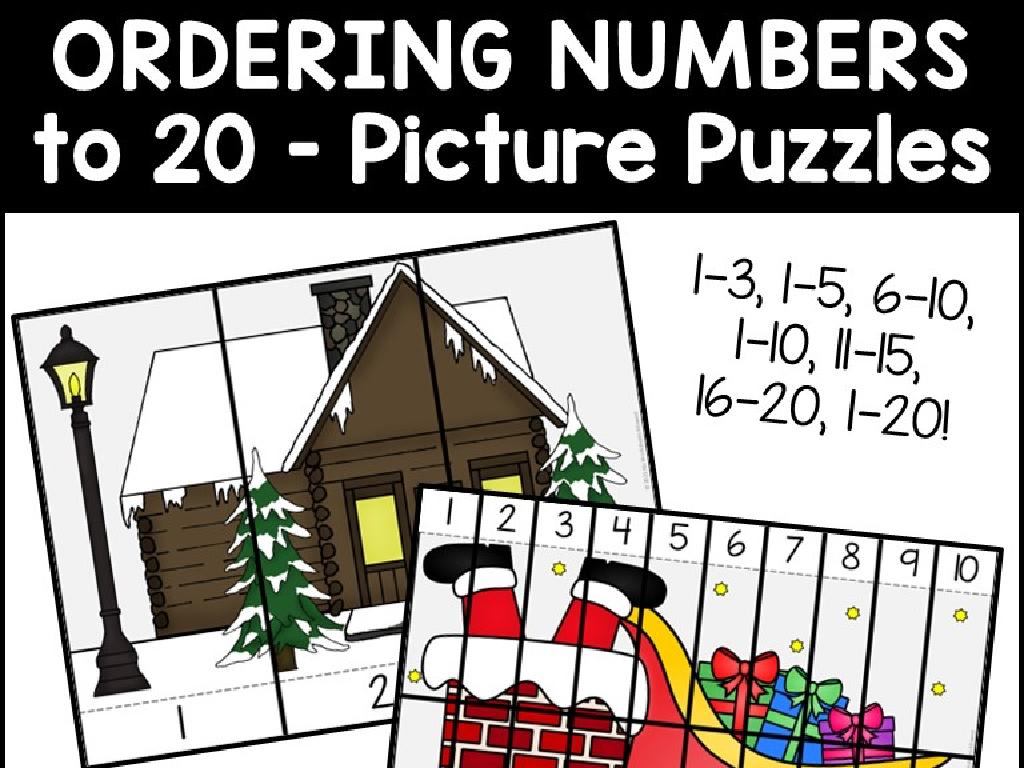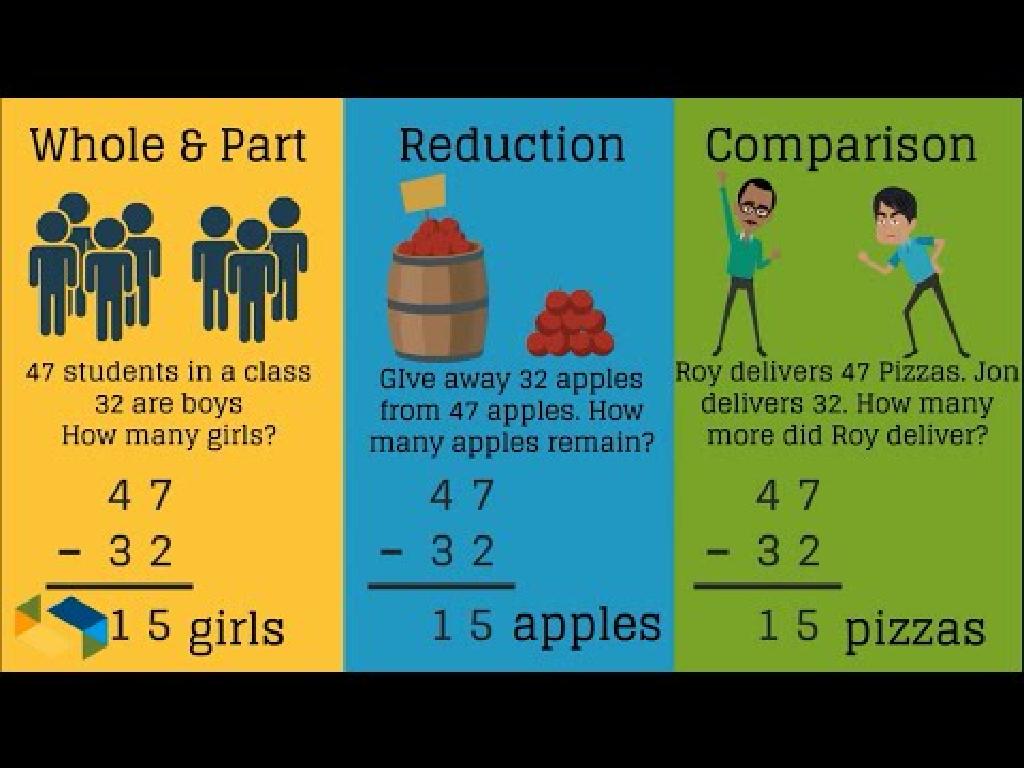Solutions To Inequalities
Subject: Math
Grade: Eighth grade
Topic: One-Variable Inequalities
Please LOG IN to download the presentation. Access is available to registered users only.
View More Content
Introduction to Inequalities
– Define inequalities
– An inequality shows the relationship between two expressions that are not equal.
– Inequalities vs. equations
– Unlike equations, inequalities do not show equality but rather a greater than, less than relationship.
– Real-life inequality examples
– Budgeting allowance, temperature ranges, or minimum height for a ride.
– Solving inequalities
– Use similar methods as equations but remember to flip the sign when multiplying or dividing by a negative.
|
This slide introduces the concept of inequalities, which are statements about the relative size or order of two objects. It’s crucial to highlight the difference between an inequality and an equation, emphasizing that an inequality shows a range of possible solutions, not just one. Provide real-life scenarios where inequalities are applicable, such as budgeting a weekly allowance or determining if someone is tall enough to ride a roller coaster. This will help students understand the practicality of inequalities. Lastly, touch on the basic principles of solving inequalities, noting especially the rule about reversing the inequality sign when multiplying or dividing by a negative number. Encourage students to think of other real-life examples and to practice solving simple inequalities for homework.
Types of Inequalities
– ‘Greater than’ (>) and ‘Less than’ ( b, a is larger than b. E.g., 5 > 3 means 5 is greater than 3.
– ‘Greater than or equal to’ (e) and ‘Less than or equal to’ (d)
– For a e b, a is larger or equal to b. E.g., 5 e 5 means 5 is greater than or equal to 5.
– ‘Not equal to’ (`)
– For a ` b, a is not the same value as b. E.g., 5 ` 4 means 5 is not equal to 4.
|
This slide introduces students to the basic types of inequalities they will encounter in algebra. Start by explaining the symbols for ‘greater than’ and ‘less than’, and ensure students understand that these inequalities do not include the number itself. Then, move on to ‘greater than or equal to’ and ‘less than or equal to’, which do include the number as a possible solution. Lastly, discuss ‘not equal to’, which indicates that the two values cannot be the same. Provide examples for each type of inequality and encourage students to come up with their own examples. This foundational knowledge is crucial for solving one-variable inequalities.
Graphing Inequalities on a Number Line
– Graphing an inequality explained
– It means to show the range of values that satisfy the inequality on a number line.
– Open vs. closed circles
– Open circle: value not included. Closed circle: value included.
– Graphing ‘x > 3’
– Place an open circle on 3 and shade to the right, indicating x is greater than 3.
|
This slide introduces students to the concept of graphing inequalities on a number line, which is a visual representation of all possible solutions to an inequality. Start by explaining what an inequality is and how it differs from an equation. Then, discuss the significance of open and closed circles: open circles represent ‘greater than’ (>) or ‘less than’ ( 3′ as an example to show how to graph inequalities. Draw a number line, place an open circle at 3, and shade the line to the right of 3 to indicate all numbers greater than 3 are solutions. Leave space for students to ask questions or provide additional examples if needed.
Solving One-Variable Inequalities
– Steps to solve inequalities
– Isolate the variable on one side
– Example: 2x + 3 > 7
– Subtract 3 from both sides, then divide by 2
– How to check your solution
– Substitute the solution into the original inequality
|
This slide introduces the process of solving one-variable inequalities. Start by explaining the steps to isolate the variable: use inverse operations to get the variable alone on one side of the inequality. For the example 2x + 3 > 7, guide students through subtracting 3 from both sides to get 2x > 4, and then dividing by 2 to find x > 2. Emphasize the importance of checking the solution by substituting it back into the original inequality to ensure it makes a true statement. This reinforces their understanding and validates their solution. Encourage students to practice with additional problems and to always check their work.
Solving One-Variable Inequalities
– Comprehend solution sets
– Solve x – 4 d 8
– Add 4 to both sides: x d 12
– Express solutions in interval notation
– Use brackets to show ranges, e.g., [a, b)
– Practice with different inequalities
|
This slide introduces students to the concept of solution sets for inequalities. Start by explaining that a solution set includes all the possible values that satisfy the inequality. Use the example x – 4 d 8 to demonstrate how to find solutions by performing the same operation on both sides of the inequality. Once the solution is found, teach students how to express it in interval notation, which is a way of writing the set of all solutions to an inequality. Finally, encourage students to practice with different inequalities to become comfortable with the process and the notation.
Understanding Compound Inequalities
– Define Compound Inequalities
– Two or more inequalities joined by ‘and’ or ‘or’
– Solve ‘And’ & ‘Or’ Inequalities
– ‘And’ means both conditions must be true; ‘Or’ means either can be true
– Graphing on a Number Line
– Use a number line to show all possible solutions
– Practice with Examples
– Let’s solve x > 3 and x < 7, and x 8 together
|
This slide introduces compound inequalities, which are two or more inequalities that work together. Students will learn the difference between ‘and’ inequalities, where both conditions must be met, and ‘or’ inequalities, where at least one condition must be met. Emphasize the importance of understanding the conjunctions ‘and’ & ‘or’ as they change the solution set. Graphing these inequalities helps visualize the solution set. Provide practice problems for students to apply these concepts, such as finding the range of values for x that satisfy both x > 3 and x < 7, or the values for x that satisfy x 8. Encourage students to check their solutions by substituting values into the original inequalities.
Solving Inequalities: Practice Problems
– Solve 5x – 2 d 3x + 4
– Isolate x by subtracting 3x and adding 2 on both sides
– Graph the solution on a number line
– Mark the solution range and open/closed circles
– Find solution set for -3 d 2y – 5 < 1
– Solve the compound inequality step by step
– Discuss solution set representation
– Understand how to express the solution in interval notation
|
This slide is aimed at providing students with hands-on practice in solving one-variable inequalities. Start by guiding them through the steps to isolate the variable in the first inequality, and then show how to represent the solution graphically. For the second problem, demonstrate how to solve a compound inequality and discuss the meaning of the solution set. Emphasize the importance of checking solutions and representing them correctly on a number line or in interval notation. Encourage students to ask questions and work through these problems in pairs or small groups for better understanding.
Class Activity: Inequality Scavenger Hunt
– Team up with a classmate
– Solve inequality clues in class
– Clues like ‘x + 3 > 5’ are hidden around
– Follow solutions to the next clue
– Each clue’s answer points where to go next
– Win a prize for solving all!
|
This interactive activity is designed to engage students with inequalities in a fun and dynamic way. Set up the classroom with hidden clues that involve solving inequalities. Ensure the difficulty is appropriate for eighth-grade students. Provide clear instructions and make sure each clue is solvable and leads to the next in a logical manner. Have a variety of prizes ready to motivate students. As they work through the clues, circulate to offer guidance and ensure everyone is participating. After the activity, discuss the different inequalities encountered and how students approached solving them. This will reinforce their learning and problem-solving skills.
Wrapping Up: Inequalities Mastery
– Recap of inequality solutions
– Why mastering inequalities matters
– Inequalities are foundational for advanced math topics.
– Homework: Inequality worksheet
– Practice with various inequality problems.
– Prepare for next class discussion
– Review homework answers together.
|
As we conclude today’s lesson on solutions to inequalities, it’s crucial to review the key concepts and methods we’ve covered. Emphasize the importance of mastering inequalities as they form the basis for understanding more complex mathematical concepts in the future. For homework, students are assigned a worksheet that includes a variety of inequality problems to solve, ensuring they apply the techniques learned in class. Encourage students to attempt all problems and be ready to discuss their solutions in the next class. This will not only reinforce their learning but also allow them to address any areas of difficulty they may encounter.






